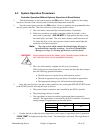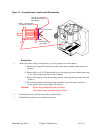
Vacuuming
Try vacuum-cleaning a soiled filter first. Vacuuming removes most large particles and
surface contaminants, and may suffice for the first time you clean a filter. Use a commercial-
duty (recommended) or household vacuum cleaner. Vacuum the filter from the air intake
(dirty) side only.
Cleaning with Compressed Air
Blow clean, dry compressed air up and down the pleats, blowing out the filter
from the inside out. Remove loose dirt from the filter with compressed air or
vacuum from the outside.
Caution! DO NOT clean/wash filter with water!
After each cleaning:
• Inspect the filter element. Briefly hold a light bulb behind the element
and look for any
fatigued paper or residual dirt. Inspect for holes
and tears by looking though the filter toward a bright light. Check for
damaged gaskets or dented metal parts. Do not re-use a damaged
filter!
• Check the gasket for damage. A damaged gasket allows contaminants
into the process. Replace as needed.
Servicing the Dew Point Monitor
The accuracy of the dew point monitor on mini dryer systems depends on proper operation of
the dew point sensor and the control board. The dew point sensor is in the process air stream
and is therefore susceptible to contamination.
Dew point sensor life depends on:
• Air temperature and flow passing over the sensor.
• The amount of fines (dust) in the process air.
• The amount of plasticizer vapor in the process air.
Once every six months, the dryer operator should monitor the initial dew point sensor
readings and establish a periodic replacement schedule as needed.
Caution! Do not attempt to check the continuity or resistance of the dew point
sensor.
The sensor will be destroyed!
Dehumidifying Dryers Chapter 5: Maintenance 36 of 53


















